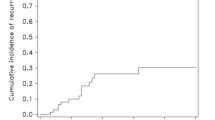Abstract
Vaginal intraepithelial neoplasia (VAIN) represents 1% of all intraepithelial neoplasia of the lower genital tract. Our aim was to study the clinical-therapeutic characteristics of patients with VAIN. A retrospective study was made of all cases of patients, who attended within the outpatient service between 1993 and 2003, with a diagnosis of VAIN. During this period, 84,293 Papanicolaou smears (triple collection) were performed and a total of 33 (50.32±11.5 years old) patients with VAIN were diagnosed. Among these patients, twenty-six (78.8%) were white, 17 (51.5%) were smokers, and 23 (69.6%) had undergone hysterectomy previously. The indications for hysterectomy prior to the appearance of VAIN were found in 20 cases (87%) of cervical intraepithelial or invasive neoplasia (CIN), and in two (8.6%) cases after myoma uterine. The median time elapsed between the hysterectomy and the appearance of VAIN was 41 months. Thirteen (39.4%), 11 (33.3%) cases were, respectively, VAIN II and III. Twenty-eight patients (84.8%) presented a single lesion affecting the upper third of the vagina. The commonest finding was the presence of white epithelium in 17 patients (51.5%). Ten of 16 cases submitted to topical application of 5-fluorouracil (5-FU) achieved remission. Surgery was utilized for seven patients, of whom six achieved remission and one had persistence of the lesion. We conclude that VAIN may occur in patients who have undergone hysterectomy due to benign alterations. This justifies the use of routine Papanicolaou tests. Both surgical and 5-FU treatments are efficient.
Similar content being viewed by others
References
Briton LA, Nasca PC, Mallin K, Schairer C, Rosenthal J, Rosenberg R, Yordan E, Richart RM (1990) Case-control study of in situ and invasive carcinoma of the vagina. Gynecol Oncol 38:39–54
Bell J, Sevin B, Averette H, Nadji M (1984) Vaginal cancer after hysterectomy for benign disease: value of cytological screening. Obstet Gynecol 64:699–702
Cardosi RJ, Bomalaski JJ, Hoffman MS (2001) Diagnosis and management of vulvar and vaginal intraepithelial neoplasia. Gynecol Oncol Generalist 28:685–702
Diakomanolis E, Stefanidis K, Rodolakis A, Haidopoulos D, Sindos M, Chatzipappas I, Michalas S (2002) Vaginal intraepithelial neoplasia: report of 102 cases. Eur J Gynecol Oncol 23:457–459
Diakomanolis E, Haidopoulos D, Dimitrios, Stefanidis K, Konstantinos (2002) Treatment of high-grade vaginal intraepithelial neoplasia with imiquimod cream. New Engl J Med 347:374
Disaia JP, Creasman WT (1989) Invasive cancer of the vagina and uretra. Clinical gynecologic oncology, 3rd edn. Mosby, London, p 273
Dodge JA, Eltabbakh GH, Mount SL, Walker RP, Morgan A (2001) Clinical features and risk of recurrence among patients with vaginal intraepithelial neoplasia. Gynecol Oncol 83:363–369
Fine BA, Piver MS, Mcauley M, Driscoll D (1996) The curative potential of radiation in the treatment of primary vaginal carcinoma. Am J Clin Oncol 19:39–44
Gonzalez JL, Murrieta GF, Brambila JC, Manzano JMD, Manzano AFA (2002) Topical 5-fluorouracil for treatment of vaginal intraepithelial neoplasia. Ginecol Obstet Méx 70:244–247
Lenehan PM, Meffe F, Lickrish GM (1986) Vaginal intraepithelial neoplasia: biologic aspects and management. Obstet Gynecol 68:333–337
Murta EFC, Murta BMT (2004) Successful pregnancy after vaginal cancer treated with interferon. Tumori 90:248–249
Rome RM, Engalnd PG (2000) Management of vaginal intraepithelial neoplasia: a series of 132 cases with long-term follow-up. Int J Gynecol Cancer 10:382–390
Sikorski M, Zrubek H (2003) Long-term follow-up of patients treated with recombinant human interferon gamma for cervical intraepithelial neoplasia. Int J Gynecol Obstet 82:179–185
Sillman FH, Frutchter RG, Chen Y-S, Camilien L, Sedlis A, McTigue E (1997) Vaginal intraepitelial neoplasia: risk factors for persistence, recurrence, and invasion and its management. Am J Obstet Gynecol 176:93–99
Stuart CGE, Allen HH, Anderson RJ (1981) Squamous cell carcinoma of the vagina following hysterectomy. Am J Obstet Gynecol 139:311–315
Author information
Authors and Affiliations
Corresponding author
Rights and permissions
About this article
Cite this article
Murta, E.F.C., Neves Junior, M.A., Sempionato, L.R.F. et al. Vaginal intraepithelial neoplasia: clinical-therapeutic analysis of 33 cases. Arch Gynecol Obstet 272, 261–264 (2005). https://doi.org/10.1007/s00404-005-0022-1
Received:
Accepted:
Published:
Issue Date:
DOI: https://doi.org/10.1007/s00404-005-0022-1




